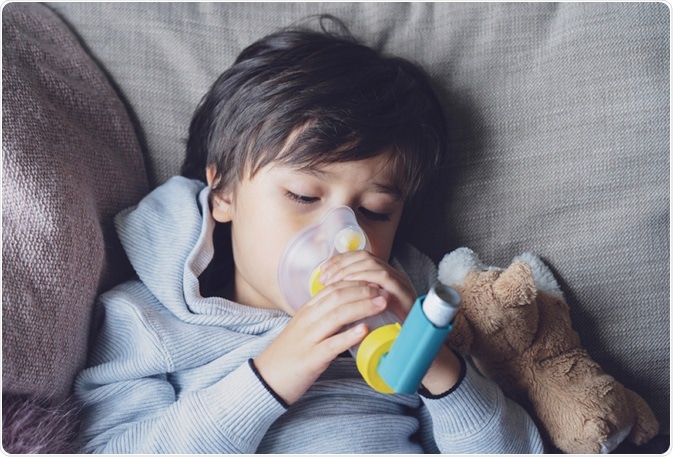Over the past 15 years, there have been major advances in the scientific understanding of asthma. Asthma is now known to be a disease of airway inflammation resulting from a complex interplay between environmental exposures and genetic and other factors. This has implications for the medical treatment and the environmental management of asthma.

Image Credit: Ann in the uk / Shutterstock
In contrast to the limited understanding of the relationship of environmental exposures to the onset of asthma, the environmental triggers of asthma attacks for children with asthma have become increasingly well characterized.
House dust mites, cockroaches, mold, and animal dander have been identified as the principal allergens that trigger asthma symptoms. Reducing exposure to these allergens has been shown to reduce asthma symptoms and the need for medication and improve lung function.
Environmental tobacco smoke is an important irritant that can trigger an asthma episode and possibly worsen allergens' effects. Upper respiratory viral infections are also recognized as important triggers for asthma episodes.
Children with asthma have long been recognized as particularly sensitive to outdoor air pollution. Many common air pollutants, such as ozone, sulfur dioxide, and particulate matter, are respiratory irritants and can exacerbate asthma.
Air pollution also might act synergistically with other environmental factors to worsen asthma. For example, some evidence suggests that exposure to ozone can enhance a person’s responsiveness to inhaled allergens. Whether long term exposure to these pollutants can actually contribute to the development of asthma is not known.
To date, little research has examined the role of other hazardous air pollutants (e.g., metals and volatile chemicals) in the development or exacerbation of asthma. However, this is an issue of increasing public concern. In addition to an improved understanding of asthma's appropriate environmental management, asthma's medical management has changed significantly.
Inhaled anti-inflammatory medications have become the mainstay of medical management to prevent asthma episodes and lessen chronic symptoms of asthma. Also, improvements in monitoring techniques now permit objective measures of lung function that are easy for patients and physicians to assess asthma severity and monitor changes in the disease.
In a disease like asthma that varies considerably over time and where changes in lung function can occur before symptoms develop, these objective measures are essential tools for making management decisions.
Childhood Asthma: A Guide for Families and Caregivers
As a result of these advances, asthma's medical and environmental management is better defined, and the knowledge exists to manage asthma better than ever before. One significant finding is that patient education has been documented to be cost-effective.
Teaching patients and their families specific management skills improve asthma management, reduces emergency services, and improves life quality. This is particularly important for asthma management since the environmental management of asthma requires knowledge of asthma triggers and specific actions that can be undertaken to reduce exposure to these triggers.
The treatment goal for almost all individuals with asthma should be for that person to lead a life unrestricted because of asthma.
Reducing exposure to environmental allergens and pollutants will reduce the frequency and severity of attacks for children with asthma, reduce their need for medicine, and improve lung function.
Children are exposed to many environmental agents that could trigger asthma attacks. For example, 25% of children in America live in areas that regularly exceed EPA limits for ozone.
Approximately 29% of households still permit the exposure of children to secondhand smoke in the home regularly. Exposure to environmental tobacco smoke is so widespread that approximately 88% of all children have some level of documented exposure (Pirkle, 1996).
A high proportion of children living in the inner city are exposed to high levels of cockroach antigen.
Asthma Epidemic
The causes of the increasing asthma rate over the past 25 years and the particular role that environmental exposures play are unknown, but there are some clues. Atopy, the genetically inherited susceptibility to becoming allergic, is the most important predictor of a child developing asthma.
A substantial research effort is underway to identify the genes that are responsible for susceptibility to asthma. Because the genetic makeup of the population changes slowly, genetic susceptibility alone cannot be responsible for the epidemic of asthma in the United States over the past 25 years.
Further work is essential to clarify how genetic susceptibility and environmental exposures interact to cause asthma. Factors such as the intensity of environmental exposure and the person's age are likely to be important.
Exposure to allergens found indoors is a strong risk factor for developing asthma. Children are spending increasing amounts of time indoors, thus increasing their exposure to indoor allergens.
The environmental exposures most strongly suspected of causing asthma to develop include environmental tobacco smoke and allergens such as house dust mites, cockroaches, mold, and animal dander.
Exposures that stimulate the immune system may also be significant, such as diet during the prenatal period and early infancy, the pattern of respiratory infections early in life, and even decreasing rates of exercise have all been suggested as risk factors for developing asthma.
Further Reading